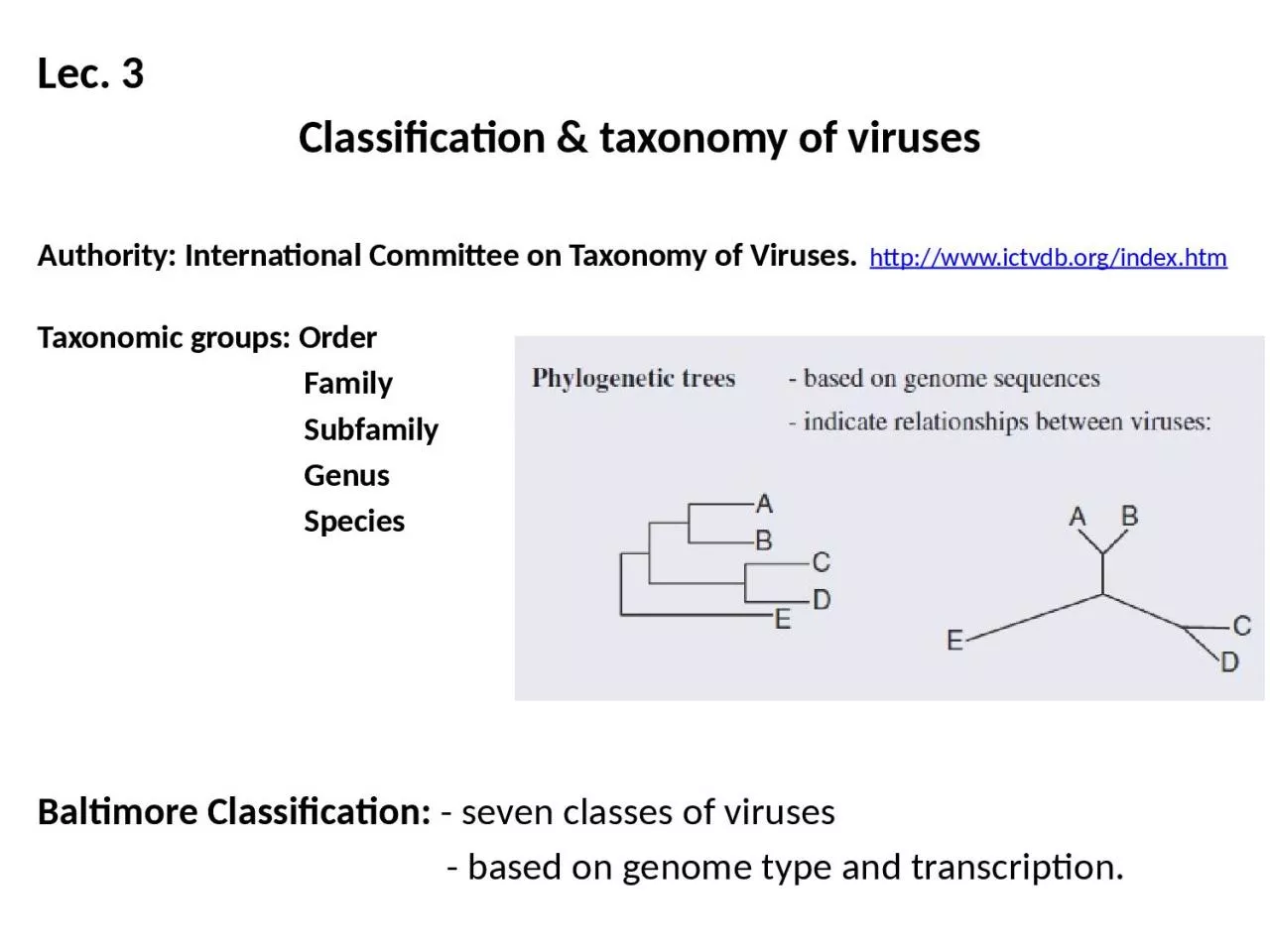

Authority International Committee on Taxonomy of Viruses http wwwictvdborgindexhtm Taxonomic groups Order Family Subfamily ID: 916369
Download Presentation The PPT/PDF document "Lec . 3 Classification & taxonomy o..." is the property of its rightful owner. Permission is granted to download and print the materials on this web site for personal, non-commercial use only, and to display it on your personal computer provided you do not modify the materials and that you retain all copyright notices contained in the materials. By downloading content from our website, you accept the terms of this agreement.
Slide1
Lec. 3Classification & taxonomy of virusesAuthority: International Committee on Taxonomy of Viruses. http://www.ictvdb.org/index.htmTaxonomic groups: Order Family Subfamily Genus SpeciesBaltimore Classification: - seven classes of viruses - based on genome type and transcription.
Slide2History of virus classification & nomenclatureVirologists are quite in need to classify the objects under study into groups and sub-groups. In the early days, when little was known about viruses, they were loosely grouped on the basis of criteria such as the type of host, the type of disease caused by infection and whether the virus is transmitted by an arthropod vector. As more was learnt about the characteristics of virus particles some of these began to be used for the purposes of classification, for examplewhether the nucleic acid is DNA or RNA whether the nucleic acid is single stranded or double stranded whether or not the genome is segmented the size of the virion whether the capsid has helical symmetry or icosahedral symmetry whether the virion is naked or enveloped.
Slide3Virus names were derived in a variety of ways:small, icosahedral, single-stranded DNA viruses of animals were called parvoviruses (Latin parvus = small).nematode-transmitted polyhedral (icosahedral) viruses of plants were called nepoviruses.phages T2, T4 and T6 were called T even phages.Serological relationships between viruses were investigated, and distinct strains (serotypes) could be distinguished in serological tests using antisera against purified virions. Serotypes reflect differences in virus proteins and have been found for many types of virus.International committee on taxonomy of viruses (ICTV)ICTV was established in 1966 to lay down the rules for the nomenclature and classification of viruses, and it considers proposals for new taxonomic groups and virus names. The committee has many working groups and is advised by virologists around the world.
Slide4Modern virus classification and nomenclatureThe taxonomic groups such as order, family, subfamily, genus, and species have been accepted and are now established. Some virus families have been grouped into orders, but higher taxonomic groupings, such as class and phylum, are not used. Only some virus families are divided into subfamilies.Many of the early names of virus groups were used to form the names of families and genera, e.g. the picornaviruses became the family Picornaviridae. Each taxonomic group has its own suffix and the formal names are printed in italic with the first letter in upper case, e.g. the genus Morbillivirus.
Slide5Classification based on genome sequencesDue to the advance in technologies for sequencing virus genomes and for determining genome organization, the modern approach to virus classification is based on comparisons of genome sequences and organizations. The degree of similarity between virus genomes can be assessed using computer programs, and can be represented in diagrams known as phylogenetic trees because they show the likely phylogeny (evolutionary development) of the viruses.
Slide6Nomenclature of viruses and taxonomic groupsMany approaches have been used in naming of individual viruses.Bacterial viruses’ names were given codes such as T1, T2, and ᵠ X174.Viruses of humans and other vertebrates were commonly named after the diseases that they cause, e.g. measles virus, smallpox virus, foot and mouth disease virus.Some viruses were named after the city, town, or river where the disease was first reported, e.g. Newcastle disease virus, Norwalk virus, Ebola virus.Some of the place names where viruses were first found have been incorporated into the names of virus families and genera.Most plant viruses were given names according to the host that is susceptible to the virus and the symptom of disease caused by the virus, e.g. potato yellow dwarf virus, tobacco rattle virus. Some of these names were given to the family and genus names.Many names of virus taxonomic groups are based on Latin words, while some have Greek origins.
Slide7Slide8Slide9Slide10Baltimore classification of virusesViruses can be grouped into seven classes on the basis of the type of genome (DNA or RNA, ss or ds) and the way in which the genome is transcribed and replicated. This approach to virus classification was first suggested by David Baltimore, after whom the scheme gained its name.The advantage of the Baltimore classification is its differentiation between plus-stranded RNA viruses (class VI) that do and (class IV) that do not carry out reverse transcription, and between dsDNA viruses (class VII) that do and (class I) that do not carry out reverse transcription. Class I: dsDNA virusesClass II: (+)DNA virusesClass III: dsRNA virusesClass IV: (+) RNA virusesClass V: (-) RNA virusesClass VI: (+) RNA (reverse transcribing viruses).Class VII: dsDNA (reverse transcribing viruses).